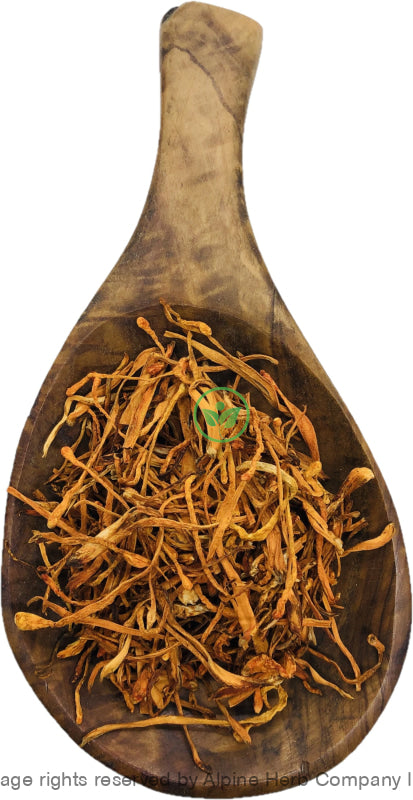Cordyceps Alpine Herb Company Inc.
$ 16,99 $ 10,19
Botanical Name: Cordyceps militaris
Common Name:
- English:
- Also, known as: Vegetable caterpillar, Chinese caterpillar fungus, Yartsa gunbu, Dong Chong xia cao, and Semitake, Jin Chong Cao, Bailing, Caterpillar Fungus, Caterpillar Mushroom, Cs-4, Champignon Chenille, Chinese Caterpillar Fungus, Chinese Cordyceps Fungus, Cordyceps sinensis, Dong Chong Xia Cao, Dong Chong Zia Cao, Hsia Ts’Ao Tung Ch’Ung, Hirsutella sinensis, Jinshuibao Jiaonang, Jinshuibao Pian, Ophiocordyceps sinensis, Tochukaso, Vegetable Caterpillar
Part Used: Fungus
Origin: China
General Information:
Cordyceps militaris has been described as a medicine in old Chinese medical books and Tibetan medicine. It is a rare combination of a caterpillar and a fungus and found at altitudes above 5000m in Sikkim.Cordyceps sinensis is a fungus traditionally grown on the bodies of caterpillars and just one species in a genus of hundreds. All species are parasites. This species is found only on the Tibetan Plateau. Other Cordyceps species grow all over the world, mainly in Asia in humid tropical forests. The name cordyceps comes from Latin words meaning club and head.
The fungus is parasitic in nature. The base of the mushroom first originates from an insect larval host and ends at the club-like cap, including the stipe and stroma. The stroma is the upper fungal part and is dark brown or black, but can be a yellow color when fresh, and longer than the caterpillar itself, usually. It grows singly from the larval head, and is clavate, sub lanceolate or fusiform, and distinct from the stipe. The stipe is slender, glabrous, and longitudinally furrowed or ridged. The immature larvae (host) on which cordyceps grows usually lies about 4-10 cm below the surface of the ground.
Precautions:
You should consult with a qualified healthcare practitioner before using any herbal products, particularly if you are pregnant, nursing, or on any medications.
All information on this website is for educational purpose ONLY
This information has not been evaluated by Health Canada.
This information is not intended to diagnose, treat, cure, or prevent any disease.
| Unit Size | 100g, 200g, 400g, 1kg |
|---|
Prompt shipping and expert packing
Thanks to our longstanding association with UPS FedEx DHL as well as other leading global carriers, we can offer a variety shipping options. Our warehouse staff is highly trained and will be able to pack your goods in accordance with our precise and exact specifications. Your items will go through an exhaustive examination before they will be securely packaged before being delivered. We ship to hundreds of thousands of customers daily in different countries. This is a sign of our determination to become the largest online retailer worldwide. Warehouses and distribution centers are located throughout Europe as well as in the USA.
Note that orders containing multiple items are processed according to the particular item.
We will thoroughly inspect all items ordered before shipping. Most orders are shipped within 48 hours. The delivery time will be between 3 and 7 working days.
Returns
The stock market is always changing. It's not entirely managed by us since we're involved with several entities, including the factory and the storage. Therefore, the actual inventory could fluctuate at any moment. Please be aware that it is possible that your order could be out of stock after you've placed your order.
Our policy lasts for 30 days. If it's been more than 30 days since the date you purchased your item We're sorry to say that we can't offer you a full exchange or refund.
You can only return a product if it is unused and still in the same state as when you received it. The item should be in the original packaging.
Related products
Herb Whole
Herb Whole
Herb Whole
Herb Whole
Herb Whole
Herb Whole
Herb Whole
Herb Whole
Herb Whole
Herb Whole
Herb Whole
Herb Whole
Herb Whole


































